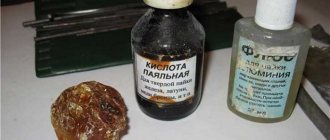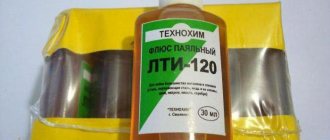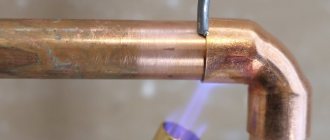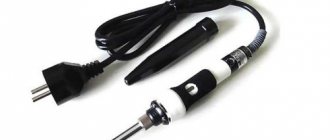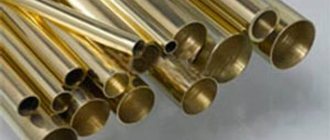I have already read several local reviews of these and other gel fluxes, but the main points remained unclear to me. I decided to write my own visual review. In addition, I'll show you the needles. Lots of GIFs, so keep an eye on the traffic. Review Items:
1)
RMA-223 Gel Flux (10cc) -
$0.62 2)
Kingbo RMA-218 Gel Flux (10cc) -
$2.87 3)
Amtech NC-559 ASM UV (TPF) Gel Flux (10cc) -
$3.74 4)
Capacity 50ml + 11 replacement needles with different diameters -
$0.90
================================== =============================================
CHRONOLOGY OF CHOICE
I’ll say in advance - these are the first three fluxes that I had the chance to use at all, because before purchasing them I used exclusively pine rosin, fiddling with which I eventually got tired of, I wanted not to waste any more time, nerves and make my work easier during installation. The choice was completely banal and standard - a request for the word “Flux” and sorting of lots on AliExpress by the number of orders. 223
turned out to be the most popular , I ordered it first, inspired by the laudatory reviews of people on the seller’s page, but after using this consumable in reality, I realized that I could not share this numerous praise.
Then someone in the comments of one of the reviews here said that he was using a 100-gram Kingbo RMA- 218
, which he was pleased with - Ali ordered the same one for himself, only in a smaller package - a syringe.
This one worked for me at work. And the rarer 559 (UV TPF)
was bought in reserve from a video on YouTube, where the author of the video also demonstrated its good properties. Later, needles were also purchased, but more about them later.
What to use it for
A novice solderer does not always appreciate the importance of the functions performed by fluxes.
There are parts, solder, soldering iron or other tools for soldering. I warmed everything up, connected it, cooled it, washed it - and it was done. In fact, the process is more complicated. Only surfaces free of oxide deposits and other impurities can bond reliably.
The solder should spread evenly in the required place, and not just anywhere. The materials must have a suitable combination that maximizes adhesion.
To do this, you need to reduce the tensile forces on the surfaces. For many types of soldering, environmental influences are not allowed. It is necessary to isolate the work area from the surrounding atmosphere.
Therefore, the main functions of flux are as follows:
removal of oxide deposits and impurities,- ensuring good solder distribution,
- improving adhesion of materials,
- protection of the connection point from air and moisture.
A good flux composition can handle all tasks. There are many of them on sale. You can make good compositions at home, but it is better to buy ready-made compositions that have been tested many times in their work.
Choosing a flux for soldering is easy. You need to have information about the available brands and take into account the specifics of the upcoming soldering.
GEL FLUXES
I don’t know anything about the original versions of the reviewed fluxes. Those who have “touched” the originals in practice can tell you more about this by comparing them with what I have. The printing of the 218
, as you can see, has almost completely worn off, but the
559
has also partially begun to peel off the coating on the label.
The cheapest 223
ironically retained its original appearance. All three options come in 10cc syringes.
Holographic stickers from Kingbo 218
and
NC-559
The caps covering the nozzles of the syringes are different for everyone, but for more expensive fluxes 218
and
559
- they are screwed onto the thread.
On the back there are caps with latches. As for the cheap 223
, it has ordinary covers on both sides without any thread or fixation.
has 218
, immediately after receiving it, I saw small bubbles inside:
And when extruding without a needle, sometimes it looked like this:
But soon after several uses, the bubbles “settled down” and came out.
I smeared a little bit of one of the fluxes on the board. From left to right: Vaseline-like substance - 223rd
, cloudy -
218th
Kingbo, more transparent -
559th
If we look at all three in ultraviolet light, we are presented with another ironic moment: the 223rd
and
the 218th
flux, where UV was not declared, are clearly visible, and
the 559th
flux, where UV was declared, is not noticeable at all:
CAPACITY 50ml and 11 NEEDLES
In its present form, using flux was inconvenient and wasteful, so I bought this kit, where I essentially don’t need the container, and what is valuable and necessary for me is the threaded needles that can be screwed onto syringes with flux.
Many people buy a polypropylene bottle for an alcohol-rosin solution, but for this purpose it is quite possible to use containers from eye drops or liquids from electronic cigarettes. Despite the fact that there is no thread on the lid nozzle, the needle fits quite tightly on it, and I still found a use for this - using the container as a pear to clear a clogged needle tube. It happened, I screwed a small diameter needle onto a syringe with flux and the tube just got clogged. The bottle helped clear it, since it can be squeezed in your hand without fear that the needle will “shoot.”
The needles themselves, as was said, are 11 pieces, of different hole diameters:
Dimensions
0.3mm, 0.4mm, 0.5mm, 0.6mm, 0.7mm, 0.8mm, 0.9mm, 1.1mm, 1.5mm and 2 identical 1.7mm
For syringes with fluxes 218
and
559
are screwed on without problems, I settled on the extreme large diameters of the needles -
1.5mm
and
1.7mm
Other applications
I didn’t wait for someone to ask or ask me about this in the comments, but decided to do it already at the stage of writing the review, namely, to use needles for soldering microcircuits with through-hole mounting.
0.9 mm
, was perfect for this task . First I tried it on the leg of a new capacitor that came to hand - it fit perfectly:
Then I tried to unsolder some multi-pin microcircuit from the old board, where I took SMD resistors from for the test:
The part was dismantled without problems. But the needle remained intact, the base of its attachment to the plastic did not collapse, since it was not exposed to strong heat.
But the component can be successfully desoldered if the needle itself passes through the hole in the board. If you need to desolder a comb whose leads are already thicker, then everything is somewhat more complicated. As an example, a comb soldered to a single-sided getinax board. I picked up a green needle 1.1mm
, however, it no longer passes through the holes of the board itself.
It is soldered, but not without dancing with a tambourine - after processing the contacts with a needle, you need to additionally tap so that the remaining solder moves away from the contacts. But in the case of double-sided boards with metalized holes, the needle will be completely powerless if it does not go through the hole. Here you can’t do without a destin pump.
The needles themselves are not clogged with anything; I did not use flux when desoldering parts.
Types of solder
What types and technologies exist? An experienced professional knows exactly what flux to use for soldering microcircuits, while a novice master must study dozens of technical literature in order to correctly determine the direction. Let's try to analyze in detail each hard metal material where you need to choose the right flux for soldering microcircuits.
- Silver. For this material, a specialized type of flux gel is used for soldering, which prevents the appearance of the so-called oxide film and allows you to degrease the soldering area. According to generally accepted rules, the surface of a silver product must be heated to a certain temperature, where a kind of protective film should form. The flux for soldering microcircuits with silver material is non-flammable and the melting range varies from +520 C to +820 C.
- Brass. In this case, the universal soldering flux SKF is used, which is also used for brass, some metal products, as well as copper, corrosion-resistant materials, galvanized iron, etc. At the end of the working process, a universal processing technology is formed, which includes anti-corrosion surface protection.
- Stainless steel. For the group of stainless metals, it is best to use orthophosphoric acid, which is classified as a middle group of inorganic components. At its core, the material forms hygroscopic miniature colorless crystal materials on its surface. When the temperature reaches +213 C, the flux material for soldering radio components turns into a new material - pyrophosphoric acid. As a result, the finished material has the ability to dissolve well in water, so in most versions it contains an 85% water solution. By the way, the liquid also has excellent ability to dissolve in solvents, as well as in ethanol. The solution also serves as a substance that cleans the surface of the workpiece from rust and other corrosive effects.
- Aluminum. Traditionally, flux is used for soldering microcircuits, which contains tin-lead solder components. But, recently, other materials have been developed for joining aluminum parts, where zinc, as well as cadmium or improved bismuth are used as components. The use of these components ensures high connection of aluminum parts. The correct choice of components for connecting aluminum depends on many minor factors, and often a “binary version of the flux” is used, where orthophosphoric or ordinary phosphoric acid is necessarily present. The no-clean process involves applying the substance in a thin layer, which ultimately produces a whitening effect on the aluminum ends of the workpiece. Upon completion of work, no additional stripping of aluminum is required.
- In radio electronics. For small and simple work with radio electronics, use a do-it-yourself flux for soldering microcircuits based on rosin, which tends to dissolve in an alcohol base. Very often a traditional alcohol-gasoline mixture is used. The main requirement for using these materials is a low degree of current leakage, as well as the lowest possible corrosion rate of the treated surface.
- Black metals. This type of material has special physical and chemical characteristics, therefore, for ferrous metals, zinc chloride-based solder is used, which has either a low (low) or medium activity level. It is recommended to use this type of flux for enamel baths. The active version of solder allows you to remove the oxide film from the surface being processed before starting the work process, as well as reduce the possible tension on the surface of the processing material. Please note that active solder material comes in powder, liquid paste, and pure liquid form. Recently, the industry has been producing a special flux paste that facilitates the work process of soldering the surface of ferrous metal products.
- Copper. To connect any copper surface of a product, a solder base is used, which contains a copper-phosphorus base, with a mandatory component composition of 15% silver. The main characteristic of such solders is the excellent adhesion of copper under extreme operating conditions, which is why this option is often used in the refrigeration industry. High fluidity is one of the positive aspects of solder, which spreads over the entire surface and ensures the filling of the pores of damaged areas of copper pipes.
It will be interesting➡ What is an integrated circuit
Soldering fat and soldering acid
Soldering fat (can be active or neutral) is needed for the same purposes as rosin, removing the invisible oxide shell from the metal and improving soldering. But if rosin does not cope with this task and cannot remove this shell from the steel, then solder fat - please! If the metal does not want to be tinned, soldering acid is used. The advantages of acid are that it degreases parts for soldering faster and better than rosin and solder fat.
Table of solders for soldering irons for microcircuits.
Its disadvantage is that after soldering it reacts with the metal for a long time, and is also a very good conductor of electric current, so self-respecting electricians and electronics engineers never use it, they have no use for extraneous current paths.
Copper, bronze, brass can be soldered with rosin or flux, lead will not be soldered with rosin, you need to solder with soldering oil. If nickel, steel or iron are used, soldering acid is used; after soldering, the remaining acid must be washed off with water. If there is a choice, then you should still choose solder fat, because... it combines the advantages of both acid and liquid rosin (flux).
Soldering flux in tube
Borax
This is a high-temperature flux (700-900*C), borax is used as a flux for soldering steel, cast iron, copper and its alloys with medium-melting copper, brass, gold and silver solders. Molten borax dissolves metal oxides and cleans the surface of the parts being soldered.
After using borax during soldering, it is necessary to remove the remaining salts using mechanical stripping. Borax and boric acid, when mixed one to one by weight, form boric flux. You need to mix the ingredients, grind thoroughly in a porcelain mortar, dissolve in distilled water while heating and evaporate to a solid residue. To increase the activity of the flux, fluoride and chloride salts are added to the mixture.
This is interesting! All about semiconductor diodes.
Oxidal
Used for cleaning soldering iron tips or for soldering oxidized leads of radio components. For best oxide action, the soldering iron should be at least 40 watts. Oxidal is sold in powder form; when working with it, it emits an unpleasant odor and the area near the soldering becomes covered with “frost.” After soldering with oxide, the residues are removed mechanically.
Oxidal for soldering
Tsaponlak
Tsaponlak is used to cover printing tracks to protect them from external influences, for example, to protect them from moisture. Over time, microcracks may appear at the places where radio components are soldered, and the penetration of water vapor into the crack over time causes the formation of non-conducting oxides.
It will be interesting➡ All about power supplies - device diagram, DIY production
Tsaponlak applied to the soldering point forms a strong surface elastic film and protects this place from moisture. Tsaponlak comes in different colors: green, red, blue. It is better to apply it to the board with a brush or soft sponge. I do not recommend covering entire printed circuit boards with tsaponvarnish (or in general with any acetone-containing substances). Special colorless varnishes are sold for these purposes.
TESTS
First, I decided to check the consumables for oxidation by applying each flux to a 2x3
on the breadboard: columns
AB - RMA-223, DE - Kingbo 218, GH - NC-559
. After which the board went to lie on the cabinet, every few days I took it out from there and took a picture. The total testing time took about a month. I noticed that many people like to ask why they need to wash off flux; the last photo in this series of pictures will clearly explain why.
It can be seen that flux 559 (UV TPF)
more active than
218
,
223
did not show any effects.
The smell and density of the smoke
RMA-223
- in its usual form, for the first time after receipt, had an uncharacteristically culinary smell, namely the smell of some spices that are used to season dishes.
Then this smell changed to neutral. There is also no pronounced odor when soldering. There is little smoke. Kingbo 218
has a pleasant fresh smell in its usual form, but when soldered, it becomes disgusting along with a large amount of smoke.
NC-559
has a light, unobtrusive chemical smell; it doesn’t really catch your nose, but when you start soldering, you realize how disgusting it is.
There is about the same amount of smoke as the 218
.
To remove vapors and smoke, I use a corrugated hood from an air conditioner, with a cooler I later integrated that works to blow air out of the room. The second end of the pipe is brought out the window.
Useful tips
The experience of experienced specialists allowed us to develop a list of useful recommendations. By following them, a novice specialist will be able to get results of good quality. Tips from the experts:
- Soldering irons with a power of 60 to 100 watts are best suited for the job. The best choice would be a 100-watt instrument. It is better to connect large structures, as well as pipelines, not with an electric soldering iron, but with a gas torch.
- When choosing an electric soldering iron, it is advisable to give preference to tools with non-burning tips.
- Tin-lead alloy consumables are the most convenient, economical and versatile. With their help, a good quality connection is obtained. When working with food tanks, kitchen or table containers, you should use solder made of pure tin without lead or other harmful additives.
- Soldering of metal structures should be performed in a well-ventilated area.
- When performing work, you must use personal protective equipment. Otherwise, you can cause irreparable harm to your health.
Contact comb
RMA-223 the 223rd
in the middle of last summer. Today, its substance has become noticeably thicker; the animation below clearly shows that it is applied in the form of a “sausage”, which, if not separated with something flat, will remain hanging from the syringe nozzle. Based on the soldering of the contacts, the expected picture emerges - “either snot or nothing.” This moment disappointed me the most at the time.
Kingbo 218
I know that in such situations it is more correct to solder while simultaneously bringing a thin wire of solder to the soldering zone, however, all my solder is either thick or flat, and besides, it was interesting to see how the fluxes would show their properties if you turn on the “lazy” mode , simply by bringing the tip with a small amount of solder to the side. As we see, the contacts are almost instantly enveloped in solder on three sides, but on the fourth side, which is facing us, it is clear that the solder did not reach the very top of the contact, but this can be solved by re-passing the tip on this side, since the flux residues will help with this .
NC-559
In this test it is slightly inferior to
the 218
- depressions appeared on the fourth side, facing our direction.
With weak acids and borax
Many craftsmen try to choose time-tested products for soldering. They prefer to work with stainless steel, nichrome, and some other metals and alloys, using concentrated phosphoric acid.
Flux is available and inexpensive. Its main disadvantages include the ability to form products that conduct electric current well. If this circumstance significantly worsens the performance of the soldered part, you should choose a different flux.
For soldering metal parts with soft solders, a group of mixtures with the designation LTI is recommended. There are several varieties of these products containing different ratios of several nitrogen-containing compounds.
For each type of flux of the LTI group, there are strictly defined recommendations that must be taken into account.
High-temperature soldering of cast iron, copper alloys, and steels with a high carbon content is carried out using borax as the flux. Its melt removes oxides and other impurities well. After work, the soldering area can be easily cleaned mechanically.
SMD mounting
A hairdryer was used with the temperature set to 340 degrees, the air flow was 90 out of 100. In these tests, you can observe the effect of surface tension, when you do not need to physically correct the SMD components if they jumped off the platform a little, because they stand up on their own as they should under the influence the above effect.
RMA-223
This cheap flux here began to show signs of suitability, the element seemed to have shrunk, but the surface of the solder remained not smooth, but somewhat loose.
Kingbo 218
When used with this flux, the components in the 1206 case tend to move, but they can be soldered; however, when installing the 0805 elements, difficulties arise - they simply fly out to the side with a stream of air, you need to hold them.
NC-559
This flux is already on the contrary - it showed itself better, element 1206 does not move, so I decided to complicate the test for it and test it on a smaller component - 0805. Here the capacitor only rears up, but the surface tension effect ultimately does its job.
Flux for soldering stainless steel and its preparation
One of the most important issues that must be resolved before soldering is the choice of the most suitable flux. Sometimes experts prefer not to buy ready-made ones, but prepare consumables themselves. The classic recipe involves the use of the following elements:
- calcium fluoride – 10%;
- boric acid – 20%;
- borax – 70%.
To join small workpieces, you can use a flux that includes only two elements: borax and boric acid in a 1:1 ratio. The dry components are mixed together in equal proportions and only after that water is added. The resulting solution is suitable for use and can be applied to the site of the future connection.
UPDATE:
Another test for the neutrality/activity of fluxes under the influence of heating with a soldering iron and subsequent cooling (thanks to u3712 for the idea), once again proving the need to wash off fluxes after work. I made a blank where I soldered two wires side by side so that each occupied 2 spots, threading two holes in the board according to the principle of sewing fabric with threads.
I connected the probes of the tester, which was turned on in resistance measurement mode, to the other ends of the wires.
Based on hydrochloric acid
A common component with great activity are compounds based on hydrochloric acid. It quickly removes all oxides when soldering steel products with soft solders.
The use of hydrochloric acid is not recommended for radio installation work. Acid activity can have unpleasant consequences. The treated areas are easily subject to subsequent corrosion, so the working area should be thoroughly washed with hot water after soldering.
Work with hydrochloric acid should be carried out carefully, under a fume hood. Vapors can damage the mucous membranes of the eyes and respiratory tract.
To work with brass, copper and steel alloys, it is advisable to choose zinc chloride in a solution of hydrochloric acid. It is easily obtained at home by adding metal to acid.
It is convenient to carry out specific types of soldering with a flux paste consisting of a saturated aqueous solution of zinc chloride and petroleum jelly.
For soldering nickel alloys and platinum, a multicomponent mixture of zinc chloride, ethyl alcohol, glycerin, and water is recommended.
Non-ferrous and precious metals are repaired by soldering with a flux consisting of rosin and zinc chloride in alcohol. After work, the joint is washed with acetone.
If you need to obtain connections with increased strength when soldering the same alloys, you should choose a flux paste made from rosin, zinc chloride and technical petroleum jelly. Washing is carried out with swabs moistened with acetone.
RMA-223
First I smeared RMA-223
between the two contacts. I applied the heated soldering iron tip to the edge of one of the contacts so as not to short them, the flux melted and I looked at the tester. As infinity was, so it remains.
I removed the soldering iron and allowed the workpiece to cool - also no change. Flux is neutral.
Kingbo 218
Exactly the same procedure, with a different flux - 218, which has already shown its activity, according to the test above, by oxidizing copper contacts, which after a while turned green.
I applied a little flux between the two contacts. He applied a heated tip. A resistance of tens of megohms appeared, which began to decrease as it warmed up to about unity, and around 1 megohm the value continued to fluctuate slightly. We remove the tip - the resistance begins to increase as it cools, up to tens of megohms and up to infinity.
NC-559
The flux also showed its activity, which oxidized and greened the copper coins on the board even faster and more intensely than the 218th
flux.
I apply flux, apply the tip, heat it up. The resistance drops to 0.2 MOhm, but then rises and settles around 1.7 MOhm.
I'm removing the sting. It's cooling down. Resistance is rising.
================================================================
